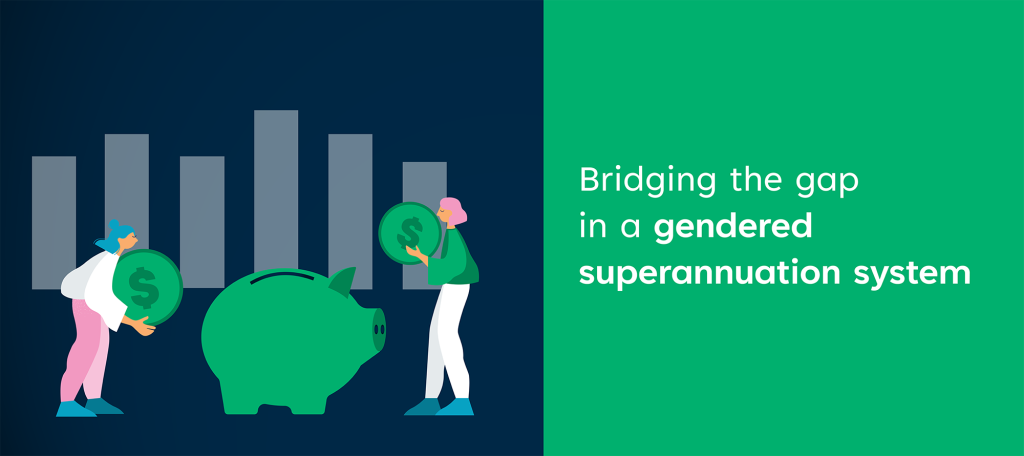Industry Super: Bridging the gender gap in a gendered superannuation system

2023 is the eleventh year Right Lane Consulting has published its significant superannuation research paper, Super Forces at Work. It is a chance for Right Lane to engage with some of the big issues facing our industry superannuation partners, from industry structure, scale and competition to big policy issues including the superannuation industry’s role in Australia’s energy transition to net zero.
This year’s report features a chapter on gender and superannuation: Bridging the gap in a gendered superannuation system. Right Lane is proud to have collaborated with Women in Super (WIS) on this chapter and thanks WIS for their ongoing advocacy in the pursuit of gender equality in superannuation.
We are deeply cognisant of the longstanding issues of gender inequality in the superannuation system and wanted to offer insights that drill into the drivers of that inequality and present options for reform. Too often in superannuation, we acknowledge the labor force issues that flow through into retirement but observe that these are not ‘problems of the retirement income system’. We think it is time to broaden our thinking.
Right Lane set out to drill down into the labour force factors that bear on women’s private savings. We see that women’s superannuation savings begin to markedly reduce compared to men’s during their 30s and the gap increases until they retire.
Gender distribution is relatively even among the bottom 50% of income earners (57% women and 43% men), but high-income jobs remain highly gendered: 74% of the top 1% of income earners are men. Women are also doing more work in lower-paying, feminized industries than they were 30 years ago.
‘The gender superannuation gap widens over the course of a woman’s career’
The gender gap
Most women still work part time. Of part time workers, 18% of women are not looking for more work for family reasons, compared to 8% of men. We also find that women are self-selecting out of doing more paid work because of caring responsibilities.
Women bore the brunt of the economic burden of COVID-19, with job losses concentrated among women aged 15-24 and 45-54. Men withdrew more superannuation through the COVID-19 Early Release Scheme, but women withdrew proportionately more of their savings.
All of this flows through into lower superannuation savings for women in retirement. A young woman who loses income for just 6 months stands to lose more than $100,000 in earnings over her lifetime.
There have been positive signs in policy development to bridge the gender superannuation gap. Valuable interventions have included the auto-consolidation of small balances, removing the $450 per month minimum earnings threshold and transparency of superannuation assets in divorce.
The momentum of these changes must continue if we are to bridge the superannuation gender gap. We know what policy changes will improve women’s earnings and therefore their retirement savings: we just have to do them. Government needs to prioritise reform to boost women’s economic participation, boost minimum award pay in feminised industries, and address the regressive system of superannuation tax concessions. The private sector needs to lift pay transparency, still only at 51% of organisations. Trustees should be active stewards of members’ capital by promoting gender equity in the places in which they invest and should invest in ways to engage female members with their savings.
Right Lane is grateful to Women in Super for their support in preparing this chapter. We look forward to working with our stakeholders to progress women’s gender superannuation equity.
More broadly, the Super Forces at Work report is always a collaborative effort with the clients we serve and the profit-to-member superannuation ecosystem we are part of. We would like to thank the 35 CEOs and senior executives who gave interviews for this year’s report, along with subscribers and contributors who shared comments on the drafts.
Want to access the ‘Bridging the gap in a gendered superannuation system’?
Right Lane and Women in Super are pleased to launch the results of their collaboration on gender and superannuation in Sydney (20 April 2023) and Melbourne (Date TBC). For more information on these launch events please contact Ellie Matchett: ellie.matchett@rightlane.com.au
The research paper, Bridging the gap in a gendered superannuation system, forms one part of the Right Lane’s Forces at Work Report. Unlike the full Forces at Work Report which is available to subscribers only, the gender chapter is available more widely to our network to support the advocacy around this important issue.
If you would like a copy of this chapter, please contact Gemma Pinnell: gemma.pinnell@rightlane.com.au
Right Lane Consulting has deep knowledge of the superannuation sector, working with not-for-profit funds across the scale spectrum. We first shared publicly our evidence-based insights on whether scale efficiencies were being realised in a consolidating superannuation environment in August 2012 and have been active participants in the debate on system structure since. Right Lane can assist in helping you to navigate these challenges and decisions and would be pleased to discuss this with you.
About Gemma Pinnell
Gemma is a principal at Right Lane Consulting. She has worked in senior positions in superannuation and the labour movement for over two decades.
Prior to joining Right Lane, Gemma was Director, Strategic Engagement at Industry Super Australia (ISA) where she was responsible for strengthening relationships between ISA and key stakeholders. During this time, she led major initiatives for ISA across a range of stakeholder, governance and engagement strategies. She has a particular focus on gender and affordable housing advocacy work.
gemma.pinnell@rightlane.com.au
Get in touch today.

